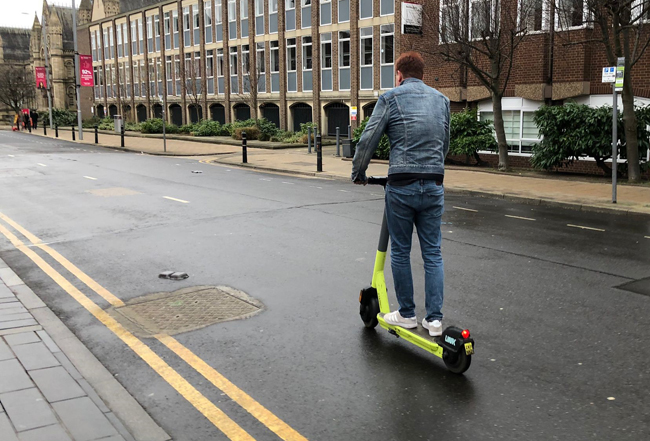Having written extensively about e-scooters over the past couple of years - while not living in an area covered by one of the many government-backed trials - I took the opportunity of a recent trip to Nottingham to try one out.
Nottingham is a very interesting city in transport terms. It has a workplace parking levy that pays for public transport services including a tram network and is often cited as an exemplar by other authorities.
It was one of five cities originally slated to have a clean air zone, but in 2018 persuaded central government that it could bring nitrogen dioxide within legal levels without one.
In March 2020 the city was named one of the Government’s Future Transport Zones and under this banner, the city’s trial e-scooter rental scheme, operated by WIND and LINK, began in 2020. It was initially a 12-month trial, but has since been extended until November 2022, in line with other schemes across the country.
Arriving in Nottingham, the yellow e-scooters were easy to spot - more often than not they were being ridden on the pavement, which is clearly against the rules. But then the city has a history of rebelling against authority.
Although there are some designated parking spaces, e-scooters can be left where riders dismount and some have complained this can create street clutter and accessibility issues. I can't say I witnessed any, but then a daytrip is not an exhaustive study.
I managed to pick one up in the Old Market Square – one of the areas of the city where the vehicles are not allowed to be ridden.
In theory, ‘geo-fencing’ prevents e-scooters being used in some areas (colour-coded red) and limits their speed in others (orange), although the latter seems to be a restriction of power rather than the speed itself.
Downloading the app and getting the e-scooter going was straightforward. A thumb-controlled lever on the handlebars regulates the power and there are bike-style brakes, as well as a bell. While you are encouraged to wear your own helmet, there is no requirement to wear one and there isn’t one provided.

The author tries out the e-scooter in a safe space
Heading up towards Nottingham Trent University, to the North of the city centre, I soon faced a problem. The signage in the street (Goldsmith Street) I wanted to travel along indicated that it was only to be used by trams, leaving me with the choice of pushing the vehicle or riding illegally.
Knowing that riding an e-scooter is permitted anywhere that cycling is allowed didn’t help here. But, further out, cycle lanes on Waverley Street provided an opportunity to use the vehicle on relatively safe section of road. The e-scooter had enough power to travel up a fairly steep hill and was able to travel back down again using gravity alone, which was quite fast enough.
A trip around the charming Arboretum (hundreds of trees in 19th-century park) provided further evidence that geo-fencing works by reducing power rather than speed in zones that are colour-coded orange. The vehicle did not provide enough power to carry me (admittedly a...second row/number 8 in Rugby) uphill.
Back in the city centre, the temporary closure of a road to through traffic gave me a further opportunity to practise a few manoeuvres in what nearby students might call a safe space. With marked parking zones outside the Victoria shopping centre (a huge John Lewis and of course a Boots) ending the ride was straightforward enough. It’s important to remember to do this via the app, or the charges keep running while you shop.
Regarding the use of e-scooters on pavements, Rosemary Healy, the council’s portfolio holder for transport, said: ‘While the e-scooter trial has proved very popular in the city, we have always acknowledged there are issues that need to be addressed, including pavement riding.
‘This is an ongoing issue in trials across the country, and in Nottingham we’ve worked with the scheme operator Wind Mobility to introduce several measures to tackle this. These include six patrollers employed by Wind to target hot spots, engage with users, and enforce correct riding.'
Ms Healy added that extending the trial had given the operator the opportunity to put in place further measures, such as ‘improved and additional enforcement, stricter fines and penalties for repeat offenders that could result in a ban, and safety events and training’.
She added: ‘While this affects all pedestrians, we are particularly aware of the impact on people with disabilities and visual impairment. We are in close contact with the Disability Inclusion Group and have regular meetings to receive feedback and provide updates on the trial.’